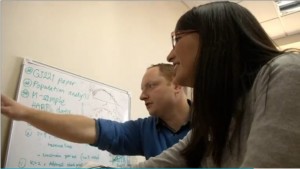 AUGUST 21(Reuters) A 25-year-old doctorate student in Chile has discovered a new planet which orbits a red star twice the size of the Sun, located 293 light years from Earth.
AUGUST 21(Reuters) A 25-year-old doctorate student in Chile has discovered a new planet which orbits a red star twice the size of the Sun, located 293 light years from Earth.
Maritza Soto Vasquez, an Astronomy student at the University of Chile, said that she had happened upon the planet by coincidence, whilst studying the red star, known as “HD 110014”, which she knew already had one planet in its orbit known as “HD110014 b”.
It was then that she came across “HD 110014 c”, which she considers “her planet”, and wrote a paper published in the Monthly Notices journal of the Royal Astronomical Society in London.
Vasquez explained that planets that orbit around a star exert a force on the latter which causes it to move. She noticed a force affecting the star, which was weaker and different to that given off by the planet previously discovered.
Vasquez and her team went on to analyse the data, in order to prove that the detected activity was n ot being produced by the star itself.
ot being produced by the star itself.
“What we wanted to do was to confirm the existence of the first planet discovered around this star. Because this star has already been studied before and a giant planet had been discovered around it. We wanted to confirm this discovery. So we studied the star’s data, a lot of very high-quality data, and we were able to find the first planet. And we said: ‘Ok, the first planet is there, it exists.’ But we observed a second signal and we tried to link it with a second planet. And after many tests we realized that the signal was not a mark on the surface of the star, or the activity of the star. The only other reason that remained for this signal was that there was a second planet orbiting the star which had not been confirmed before,” Vasquez told Reuters on Wednesday (August 19).
The process began in November and took eight months to complete, using Feros and Harps telescopes at the La Silla observatory, on the outskirts of the Atacama Desert.
Just one month ago, a Brazilian-led team at the same observatory, identified a solar system reportedly similar to our own, complete with a “twin” Jupiter revolving a Sun-like star.
Vasquez’s planet has a mass three times that of Jupiter and almost 100 times that of the Earth, taking 130 days to orbit its star.
According to Vasquez, the planet is closer to its star than the Earth is to the Sun. It can be compared to a planet three times the size of Jupiter, in the place of Venus, she said.
Her professor at the University of Chile, the Scottish astronomer, James Jenkins, emphasised the significance of the discovery.
“This is a very important discovery that my student Maritza has made. It’s a giant planet about three times the mass of Jupi
ter. And Jupiter is the most massive planet in the solar system. So this is a giant planet, but the important factor here is it’s also orbiting a giant star, a giant star about the mass twice that of our sun. So we need to understand these giant planets in order to understand how they form. We need to discover them around all types of stars. Stars like the sun, stars much smaller than the sun, and stars much more massive, much bigger than the sun. And this is what we have done today,” said Jenkins.
“So this system has two planets now. Previously, it was thought there was only one planet. But we discovered a new planet with an orbit about 130 days around the star. So now what we have is an outer giant planet that was known previously. And now we have discovered another giant planet interior to that orbit,” he added.
There are believed to be very few giant red stars with planets in their orbit, as they tend to consume those that come too close. One in five planets which have been discovered orbit a star, though Jenkins said he does not rule out discovering a third planet orbiting HD110014.
The young astronomer said she has been fascinated by the universe since she was 11-years-old. She used to study the photos in encyclopaedias she had at home and breezed through mathematics and physics at school.
Things became more complicated at university as she failed mechanics and had to drop back one year, but nowadays Vasquez sees this in a positive light as it gave her more time for research, helping to lead to her great personal success.
“One dreams of being able to make a concrete scientific discovery, and knowing that I discovered another planet which is now registered is something very important for me,” Vasquez said.







